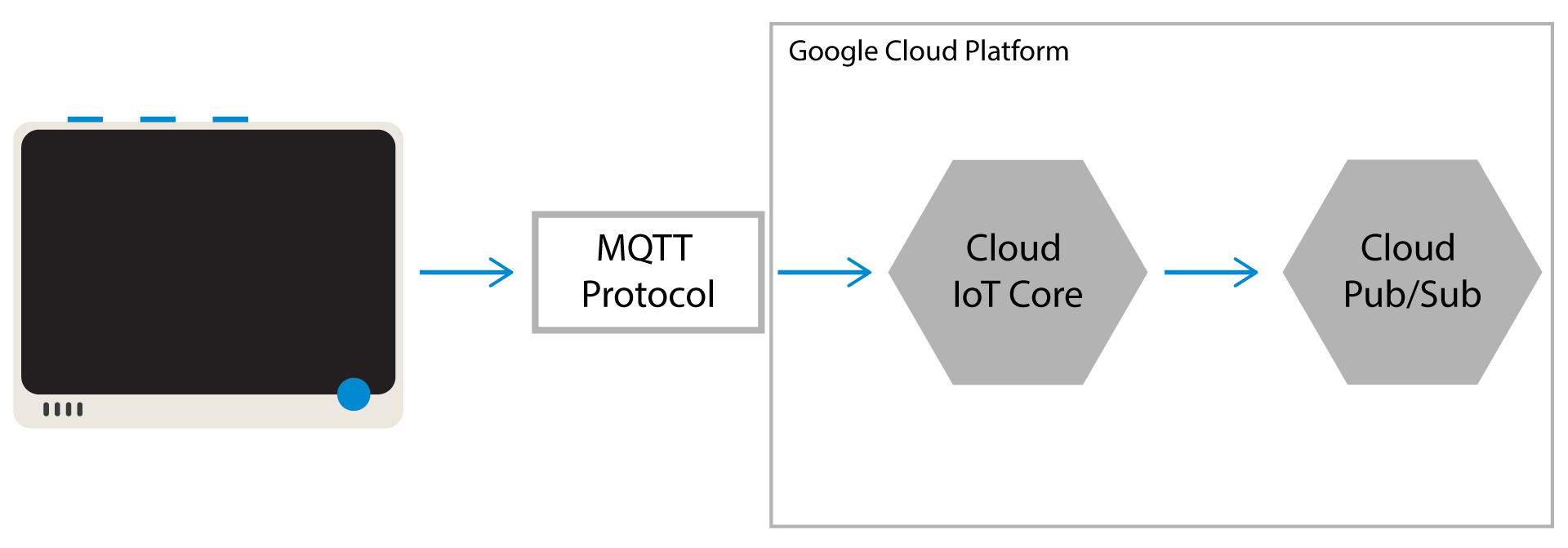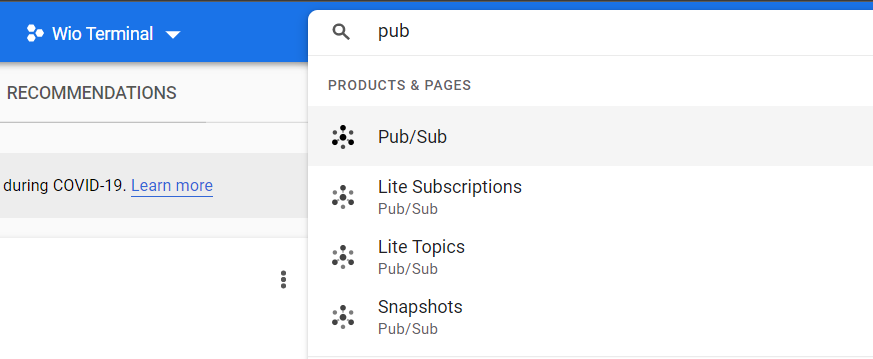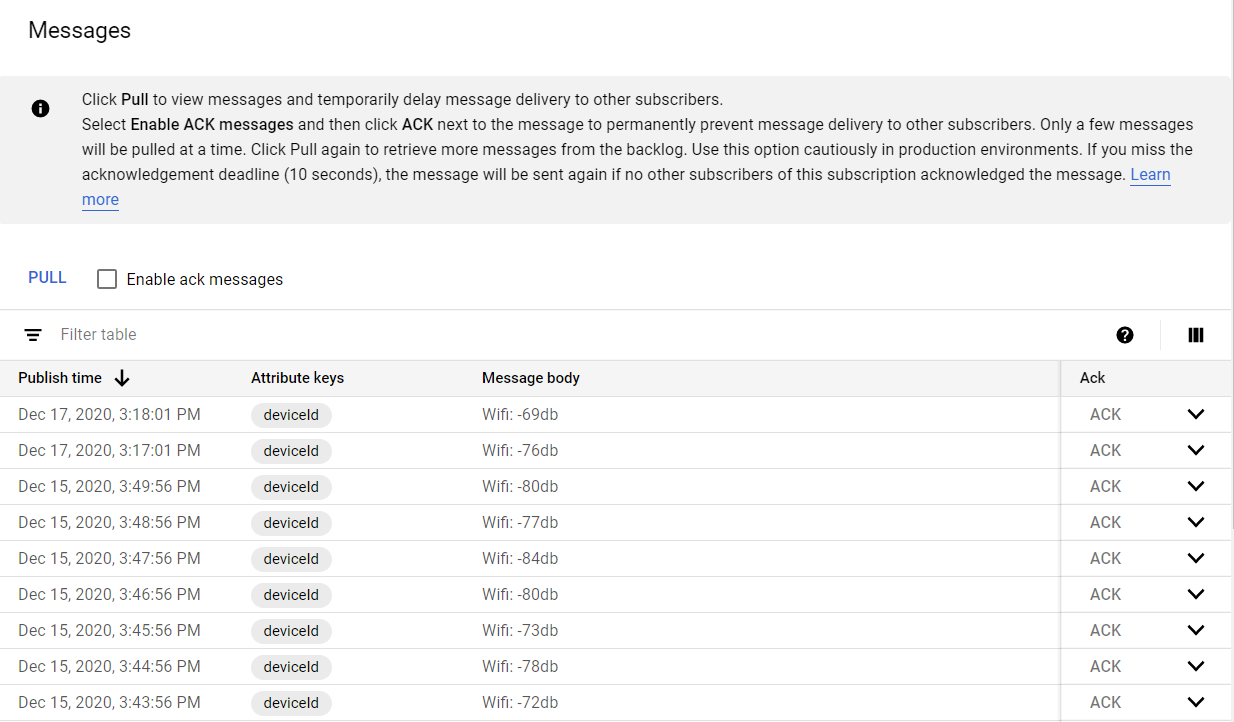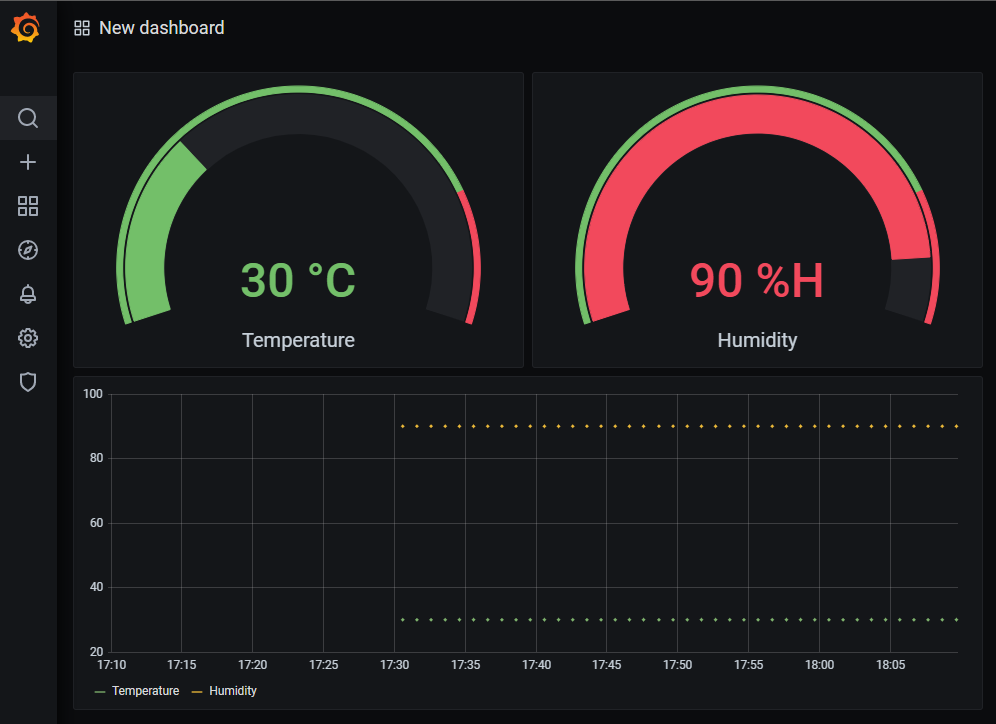Connect Wio Terminal to Google Cloud IoT Core

Upgradable to Industrial Sensors
With the SenseCAP S2110 controller and S2100 data logger, you can easily turn the Grove into a LoRaWAN® sensor. Seeed not only helps you with prototyping but also offers you the possibility to expand your project with the SenseCAP series of robust industrial sensors.
The IP66 housing, Bluetooth configuration, compatibility with the global LoRaWAN® network, built-in 19 Ah battery, and powerful support from APP make the SenseCAP S210x the best choice for industrial applications. The series includes sensors for soil moisture, air temperature and humidity, light intensity, CO2, EC, and an 8-in-1 weather station. Try the latest SenseCAP S210x for your next successful industrial project.
Introduction
In this tutorial, we will walk you through the process of connecting the Wio Terminal to Google Cloud IoT Core and send telemetry data from the Wio Terminal to the Google Cloud IoT core. This will be divided into two sections where the first section will talk about how to use the exciting libraries to send telemetry data preconfigured in the code, whereas the second section will talk about how to add your own sensors to the Wio Terminal to send the telemetry data to Google Cloud IoT Core. Google Cloud IoT Core supports both HTTP and MQTT protocols for communication, but however we will be using the MQTT protocol in this tutorial.
What is Google Cloud?
Google Cloud consists of a set of physical assets, such as computers and hard disk drives, and virtual resources, such as virtual machines (VMs), that are contained in Google's data centers around the globe. This distribution of resources provides several benefits, including redundancy in case of failure and reduced latency by locating resources closer to clients.
In cloud computing, what you might be used to thinking of as software and hardware products, become services. These services provide access to the underlying resources. The list of available Google Cloud services is long, and it keeps growing. When you develop your website or application on Google Cloud, you mix and match these services into combinations that provide the infrastructure you need, and then add your code to enable the scenarios you want to build.
What is Google Cloud Platform?
Google Cloud Platform (GCP) is a collection of cloud computing services. With a set of management tools, it provides a series of modular cloud services including computing, data storage, data analytics and machine learning. It provides infrastructure as a service, platform as a service, and serverless computing environments.
What is Google Cloud IoT Core?
Google Cloud Internet of Things (IoT) Core is a fully managed service for securely connecting and managing IoT devices, from a few to millions. Ingest data from connected devices and build rich applications that integrate with the other big data services of Google Cloud Platform.
What is Google Cloud Console?
Google Cloud Console provides a web-based, graphical user interface that you can use to manage Google Cloud Platform resources. When you use the Cloud Console, you create a new project, or choose an existing project, and use the resources that you create in the context of that project. You can create multiple projects, so you can use projects to separate your work in whatever way makes sense for you. For example, you might start a new project if you want to make sure only certain team members can access the resources in that project, while all team members can continue to access resources in another project.
Connecting Wio Terminal to Google Cloud IoT Core via MQTT
As explained before, we will be using the availble MQTT bridge for the communication between the Wio Terminal and the Google Cloud IoT Core. However, you may use the HTTP bridge as well, if that is your requirement.

Google Cloud Console Set Up
First we need to visit the Google Cloud Console, create a Cloud IoT Core device registry and register a device.
Intial Setup
- STEP 1: Visit here to create a new project
Note: Log in to your Google account if prompted
STEP 2: Click Select a project menu
STEP 3: Click NEW PROJECT and enter a project name
STEP 4: Click CREATE
STEP 5: Enable billing for your Cloud project. This is required to make sure you are not a robot and you will not be charged. Choose "Billing" under the navigation menu and go through the set up.

- STEP 6: Visit here to enable the Cloud IoT Core and Cloud Pub/Sub APIs
Note: Choose the project that you created before from the drop-down menu
Create a Device Registry
STEP 1: Visit Google Cloud IoT Core page in Cloud Console
STEP 2: Click Create Registry
STEP 3: Enter a registry ID
Note: This is the name of your registry
- STEP 4: Select a Region
Note: If you're in the US, select us-central1 for the Region. If you're outside the US, select your preferred region.
STEP 5: In the Select a Cloud Pub/Sub topic dropdown list, select Create a topic and type your preferred Topic ID
STEP 6: Click CREATE TOPIC
STEP 7: Click on SHOW ADVANCED OPTIONS
STEP 8: The Device state topic and Certificate value fields are optional, so leave them blank
STEP 9: Select MQTT for the Protocol
STEP 10: Click Create on the Cloud IoT Core page
Now we have created a device registry with a Cloud Pub/Sub topic for publishing device telemetry events
Generate a Device Key Pair (EC Keys)
Cloud IoT Core uses public key (or asymmetric) authentication
- The device uses a private key to sign a JSON Web Token (JWT). The token is passed to Cloud IoT Core as proof of the device's identity.
- The service uses the device public key (uploaded before the JWT is sent) to verify the device's identity.
Cloud IoT Core supports the RSA and Elliptic Curve algorithms, and we will be using Elliptic Curve keys in this tutorial.
STEP 1: Create a new folder on your PC
STEP 2: Navigate to the folder from a terminal window and type the following to generate a P-256 Elliptic Curve key pair
openssl ecparam -genkey -name prime256v1 -noout -out ec_private.pem
openssl ec -in ec_private.pem -pubout -out ec_public.pem
Note: Make sure to install openssl by following this link and adding the directory location to PATH.
The above commands create the following public/private key pair:
- ec_private.pem: The private key that must be securely stored on the device and used to sign the authentication JWT.
- ec_public.pem: The public key that must be stored in Cloud IoT Core and used to verify the signature of the authentication JWT.
Extract the Private Key
We need to extract the private key bytes and copy them into the private key string in the Arduino project that we will create later in this tutorial. Save these keys for now to use later.
STEP 1: Open a terminal window and navigate to the folder containing the Elliptic Curve key pair that we generated before.
STEP 2: Type the following command
openssl ec -in ec_private.pem -noout -text
- STEP 3: Copy and paste the generated private key bytes under priv: into a notepad and save for later use.
Add a Device to the Registry
STEP 1: Visit the Registries page and select the registry that you created before
STEP 2: Select the Devices tab and click CREATE A DEVICE
STEP 3: Enter a Device ID
STEP 4: The Device metadata field is optional, so leave it blank
STEP 5: Click on the COMMUNICATION, CLOUD LOGGING, AUTHENTICATION drop-down menu
STEP 6: Select Allow for Device communication
STEP 7: Inside the Authentication field, under Input method, select Upload
STEP 8: Select ES256 from the Public key format drop-down menu
STEP 9: Under Public key value, press the BROWSE button ,navigate to the Elliptic Curve key pair folder that we created before and select ec_public.pem
STEP 10: Click Create
You have now added a device to your registry. The ES256 key appears on the Device details page for your device.
Set up a Subscriber
Now that we have created a device registry, created a topic and added a device to that registry, let's move on to creating a subscriber to subcribe to the topic we have created, in order to grab the telemetry data from the Wio Terminal.
- STEP 1: Type Pub on the search bar of Google Cloud Console and select Pub/Sub from the results

STEP 2: Click Subscriptions on the navigation menu
STEP 3: Click CREATE SUBSCRIPTION
STEP 4: Enter a Subscription ID of your choice
STEP 5: Select the Pub/Sub topic that we previously created from the Select a Cloud Pub/Sub topic drop-down menu
STEP 6: Select Pull as the Delivery type
STEP 7: Click Create
Now we have finished setting up the Google Cloud IoT Core. Next, we will move on to setting up the Wio Terminal along with the Arduino IDE.
Arduino Set Up with Wio Terminal
Needed Libraries
We need two libraries for this tutorial.
- lwMQTT MQTT Arduino Library
- Google Cloud IoT Arduino Library
To download these libaries:
- STEP 1: Open Arduino IDE
- STEP 2: Navigate to
Sketch > Include Library > Manage Libraries - STEP 3: Type lwMQTT and Google Cloud IoT in the search box and install the libraries
Credentials and Account Information Configuration
Now we need to set the Wi-Fi credentials and Google Cloud IoT Core information in the ciotc_config.h file.
STEP 1: Inside Arduino IDE,
File > Examples > Google Cloud IoT JWT > Esp32-lwmqttSTEP 2: Navigate to ciotc_config.h
STEP 3: Change the Wifi network details
const char *ssid = "Enter_SSID";
const char *password = "Enter_Password";
- STEP 4: Change the Google Cloud IoT details
const char *project_id = "Enter_Project_ID";
const char *location = "Enter_location";
const char *registry_id = "Enter_Registry_ID";
const char *device_id = "Enter_Device_ID";
- STEP 5: Copy the private key bytes that we obtained from ec_private.pem and saved into notepad before
const char *private_key_str =
"6e:b8:17:35:c7:fc:6b:d7:a9:cb:cb:49:7f:a0:67:"
"63:38:b0:90:57:57:e0:c0:9a:e8:6f:06:0c:d9:ee:"
"31:41";
Note: The key length should be 32 pairs of hex digits
Change NTP Time Methods
Open esp32-mqtt.h and replace the entire file with the following codes. Here we have replaced configTime function with the implementation of obtaining NTP time via UDP.
#include <Client.h>
#include <rpcWiFi.h>
#include <WiFiClientSecure.h>
#include <MQTT.h>
#include <CloudIoTCore.h>
#include <CloudIoTCoreMqtt.h>
#include "ciotc_config.h" // Update this file with your configuration
// !!REPLACEME!!
// The MQTT callback function for commands and configuration updates
// Place your message handler code here.
void messageReceived(String &topic, String &payload){
Serial.println("incoming: " + topic + " - " + payload);
}
///////////////////////////////
// Initialize WiFi and MQTT for this board
//Client *netClient;
CloudIoTCoreDevice *device;
CloudIoTCoreMqtt *mqtt;
MQTTClient *mqttClient;
unsigned long iat = 0;
String jwt;
WiFiUDP udp;
unsigned int localPort = 2390;
unsigned long devicetime;
const int NTP_PACKET_SIZE = 48; // NTP time stamp is in the first 48 bytes of the message
byte packetBuffer[NTP_PACKET_SIZE]; //buffer to hold incoming and outgoing packets
// send an NTP request to the time server at the given address
unsigned long sendNTPpacket(const char* address) {
// set all bytes in the buffer to 0
for (int i = 0; i < NTP_PACKET_SIZE; ++i) {
packetBuffer[i] = 0;
}
// Initialize values needed to form NTP request
// (see URL above for details on the packets)
packetBuffer[0] = 0b11100011; // LI, Version, Mode
packetBuffer[1] = 0; // Stratum, or type of clock
packetBuffer[2] = 6; // Polling Interval
packetBuffer[3] = 0xEC; // Peer Clock Precision
// 8 bytes of zero for Root Delay & Root Dispersion
packetBuffer[12] = 49;
packetBuffer[13] = 0x4E;
packetBuffer[14] = 49;
packetBuffer[15] = 52;
// all NTP fields have been given values, now
// you can send a packet requesting a timestamp:
udp.beginPacket(address, 123); //NTP requests are to port 123
udp.write(packetBuffer, NTP_PACKET_SIZE);
udp.endPacket();
}
unsigned long getNTPtime() {
// module returns a unsigned long time valus as secs since Jan 1, 1970
// unix time or 0 if a problem encounted
//only send data when connected
if (WiFi.status() == WL_CONNECTED) {
//initializes the UDP state
//This initializes the transfer buffer
udp.begin(WiFi.localIP(), localPort);
sendNTPpacket(ntp_primary); // send an NTP packet to a time server
// wait to see if a reply is available
delay(1000);
if (udp.parsePacket()) {
// Serial.println("udp packet received");
// Serial.println("");
// We've received a packet, read the data from it
udp.read(packetBuffer, NTP_PACKET_SIZE); // read the packet into the buffer
//the timestamp starts at byte 40 of the received packet and is four bytes,
// or two words, long. First, extract the two words:
unsigned long highWord = word(packetBuffer[40], packetBuffer[41]);
unsigned long lowWord = word(packetBuffer[42], packetBuffer[43]);
// combine the four bytes (two words) into a long integer
// this is NTP time (seconds since Jan 1 1900):
unsigned long secsSince1900 = highWord << 16 | lowWord;
// Unix time starts on Jan 1 1970. In seconds, that's 2208988800:
const unsigned long seventyYears = 2208988800UL;
// subtract seventy years:
unsigned long epoch = secsSince1900 - seventyYears;
// adjust time for timezone offset in secs +/- from UTC
// WA time offset from UTC is +8 hours (28,800 secs)
// + East of GMT
// - West of GMT
// long tzOffset = 28800UL;
long tzOffset = 0UL;
// WA local time
unsigned long adjustedTime;
return adjustedTime = epoch + tzOffset;
}
else {
// were not able to parse the udp packet successfully
// clear down the udp connection
udp.stop();
return 0; // zero indicates a failure
}
// not calling ntp time frequently, stop releases resources
udp.stop();
}
else {
// network not connected
return 0;
}
}
///////////////////////////////
// Helpers specific to this board
///////////////////////////////
String getDefaultSensor(){
return "Wifi: " + String(WiFi.RSSI()) + "db";
}
String getJwt(){
Serial.println("Refreshing JWT");
iat = getNTPtime();
Serial.println(iat);
jwt = device->createJWT(iat, jwt_exp_secs);
Serial.println(jwt);
return jwt;
}
void setupWifi(){
Serial.println("Starting wifi");
WiFi.mode(WIFI_STA);
// WiFi.setSleep(false); // May help with disconnect? Seems to have been removed from WiFi
WiFi.begin(ssid, password);
Serial.println("Connecting to WiFi");
while (WiFi.status() != WL_CONNECTED){
delay(100);
}
// configTime(0, 0, ntp_primary, ntp_secondary);
Serial.println("Waiting on time sync...");
// Serial.println(getNTPtime());
while (getNTPtime() < 1510644967){
delay(10);
}
}
void connectWifi(){
Serial.print("checking wifi...");
while (WiFi.status() != WL_CONNECTED){
Serial.print(".");
delay(1000);
}
}
///////////////////////////////
// Orchestrates various methods from preceeding code.
///////////////////////////////
bool publishTelemetry(String data){
return mqtt->publishTelemetry(data);
}
bool publishTelemetry(const char *data, int length){
return mqtt->publishTelemetry(data, length);
}
bool publishTelemetry(String subfolder, String data){
return mqtt->publishTelemetry(subfolder, data);
}
bool publishTelemetry(String subfolder, const char *data, int length){
return mqtt->publishTelemetry(subfolder, data, length);
}
void connect(){
connectWifi();
mqtt->mqttConnect();
}
WiFiClientSecure netClient;
void setupCloudIoT(){
device = new CloudIoTCoreDevice(
project_id, location, registry_id, device_id,
private_key_str);
setupWifi();
// netClient = new WiFiClientSecure();
mqttClient = new MQTTClient(512);
mqttClient->setOptions(180, true, 1000); // keepAlive, cleanSession, timeout
mqtt = new CloudIoTCoreMqtt(mqttClient, &netClient, device);
mqtt->setUseLts(true);
mqtt->startMQTT();
}
Add Macro Definition to Esp32-lwmqtt.ino
Add Wio Terminal board to macro definitions inside Esp32-lwmqtt.ino
#if defined(ESP32) || defined(WIO_TERMINAL)
#define __ESP32_MQTT_H__
#endif
Now we have finished setting up Arduino IDE. Finally you need to Upload this code to Wio Terminal. Open Serial Monitor and you will see the following displayed.

Display Telemetry Data
Now we need to display the incoming telemetry data from the Wio Terminal. Here in this example code, the Wi-Fi signal strength will be sent as telemetry data.
- STEP 1: Visit Pub/Sub in Google Cloud Console
Note: You can search Pub in the search bar within Google Cloud Console
STEP 2: Navigate to Subscriptions inside Navigation Menu
STEP 3: Select the subscription ID that we created before
STEP 4: Click on VIEW MESSAGES
STEP 5: Click on PULL and you will see the incoming telemetry data as follows.

How to Add Other Sensors?
You can add any sensor to the Wio Terminal and send telemetry data to Google Cloud IoT Core. For simplicity, we will use the built-in light sensor on the Wio Terminal to send light intensity levels to Google Cloud IoT Core.
Google Cloud IoT Set Up
- STEP 1: Visit IoT Core in Google Cloud Console
Note: You can search IoT Core in the search bar within Google Cloud Console
STEP 2: Select the registry that we created before
STEP 3: Under Cloud Pub/Sub topics select Add or edit topics
STEP 4: Click ADD ADDITIONAL TOPIC
STEP 5: Click CREATE A TOPIC from the drop-down menu of Select a Cloud Pub/Sub topic
STEP 6: Enter a Topic ID and click CREATE TOPIC
STEP 7: Enter a Subfolder name inside the Subfolder column
Note: Subfolder name will be used to relate to the topic in the Arduino code
STEP 8: Click UPDATE
STEP 9: Create a new subscription as explained before
Arduino Set Up
Navigate to Esp32-lwmqtt.ino and add the following
- STEP 1: After the loop, add the following for the built-in light sensor
void loop() {
int light = analogRead(WIO_LIGHT); //assign variable to store light sensor values
light = map(light,0,1023,0,100); //Map sensor values
- STEP 2: Add the topic with the Subfolder name
publishTelemetry(getDefaultSensor());
publishTelemetry("/light",String(light));
Note: If a subfolder name is not added, telemetry data will be sent to the default topic. In this case, the telemetry data for Wi-Fi signal strength as explained before will be sent to the first topic that we crated before which is the default topic.
After you upload the code to the Wio Terminal, pull from the newly created topic as a subscriber and you will see the following result.

How to Add Other Sensors And Visualize Data on Dashboards?
Eventhough Google Cloud IoT Core doesn't offer a ready-to-use dashboard to visualize the data from sensors, we will explain how to achieve this by using InfluxDB and Grafana.
InfluxDB is a time series database,that is each data in InfluxDB is associated with a particular timestamp which shows date and time associated with a particular data. Whereas Grafana is an open source solution for running data analytics, pulling up metrics that make sense of the massive amount of data and to monitor apps with the help of customizable dashboards.
Basically, we will connect a temperature/ humidity sensor to the Wio Terminal, use a Google Cloud Function to transmit data from a Pub/Sub to a InfluxDB located in a GKE (Google Kubernetes Engine) cluster and display the data from InfluxDB on Grafana using interactive dashboards.

Hardware Set Up for Arduino
Connect the Grove - Temperature and Humudity Sensor (DHT11) to the Grove - Digital/Analog Port (D0) of the Wio Terminal.
Software Set Up for Arduino
STEP 1: Visit the Grove - Temperature and Humidity Sensor repo and download it as a zip file
STEP 2: Open Arduino, navigate to
Sketch > Include Library > Add .ZIP Libraryand select the downloaded library to install it
Navigate to the previously used Esp32-lwmqtt.ino and add the following:
- STEP 1: Add the following after #include "esp32-mqtt.h"
#include "DHT.h" //DHT library
#define DHTPIN 0 //Define Signal Pin of DHT
#define DHTTYPE DHT11 //Define DHT Sensor Type
DHT dht(DHTPIN, DHTTYPE); //Initializing DHT sensor
- STEP 2: Add the following inside the setup to start the DHT sensor
dht.begin();
- STEP 3: Add the following inside the if loop within void loop()
int temperature = dht.readTemperature(); //Assign variable to store temperature
int humidity = dht.readHumidity(); //Assign variable to store humidity
String payload = String("{\"timestamp\":") + getNTPtime() +
String(",\"temperature\":") temperature +
String(",\"humidity\":") + humidity +
String("}");
publishTelemetry(payload);
Note: Here we parse all the data as a string into influxDB. Parsing the time is important because influxDB is a time series database. Also the pushTelemetry function will send the data to the default topic we have created at the very beginning of this tutorial.
- STEP 4: Upload the code to the Wio Terminal
Google Cloud IoT Set Up
STEP 1: Visit this repo and download it as a zip file
STEP 2: Extract the downloaded zip file
STEP 3: Open Google Cloud Console and navigate to Google Kubernetes Engine and wait for the system to initialize
STEP 4: Start the Cloud shell by pressing the button on the top right corner

- STEP 5: Type the following commands to set defaults for the gcloud command-line tool
export ZONE=<enter_zone> # e.g. us-central1-a, see https://cloud.google.com/compute/docs/regions-zones/#available
export PROJECT_ID=<enter_project-id> # project ID name
gcloud config set project $PROJECT_ID
gcloud config set compute/zone $ZONE
- STEP 6: Type the following commands to create a GKE cluster with one n1-standard-1 node
gcloud container clusters create influxdb-grafana \
--num-nodes 1 \
--machine-type n1-standard-1 \
--zone $ZONE
- STEP 7: Type the following commands to create a secret to store InfluxDB and Grafana auth information
kubectl create secret generic influxdb-grafana \
--from-literal=influxdb-user=admin \
--from-literal=influxdb-password=passw0rd \
--from-literal=grafana-user=admin \
--from-literal=grafana-password=passw0rd
Note: You can change influxdb/ grafana usernames and passwords according to your preference
STEP 8: Click on Open Editor within Google Shell
STEP 9: Drag and drop the previously downloaded and extracted folder into Cloud Shell Editor
STEP 10: Click on Open Terminal to go back to terminal. Navigate to 05-influxdb_grafana_k8s directory by typing the following
cd esp32-cloud-iot-core-k8s-master/05-influxdb_grafana_k8s
- STEP 11: Type the following commands to deploy InfluxDB and Grafana to Kubernetes
kubectl create -f k8s/
Grafana Setup
- STEP 1: Type the following to check the services external IPs / ports
kubectl get services
STEP 2: Copy the external IP of Grafana
STEP 3: Visit
http://<grafana service external ip>:3000
Note: Paste the previously copied Grafana external IP to <grafana service external ip>
STEP 4: Log in to Grafana with the previously set credentials
STEP 5: Click on the gear icon and navigate to
Configuration > Data SourcesSTEP 6: Click Add data source and select influxDB
STEP 7: Enter the following into the URL field
http://influxdb:8086
- STEP 8: Enter the following in the Database field and click Save & Test
iot
Note: You should see the message Data source is working, if you have sucessfully set up InfluxDB data source on Grafana
Create a Google Cloud Function
Now we need to create a Google Cloud Function to transmit data from a topic on Pub/Sub to InfluxDB and display the data from InfluxDB on Grafana using interactive dashboards.
STEP 1: Go back to Google Cloud Console and open the Cloud Shell
STEP 2: Type the following to enable Cloud Functions API
gcloud services enable cloudfunctions.googleapis.com
- STEP 3: Navigate to 06-cloud_function directory by typing the following
cd esp32-cloud-iot-core-k8s-master/06-cloud_function
- STEP 4: Open main.py in a vim text editor
cd esp32-cloud-iot-core-k8s-master/06-cloud_function
STEP 5: Press i on the keyboard to enter editing mode
STEP 6: modify InfluxDB variables (host, port, username, password) in the _get_influxdb_client function
Note: Obtain the InfluxDB host by typing the following on Cloud Shell and copying the external IP
kubectl get services
STEP 7: Save the file by typing :wq
STEP 8: Deploy the Cloud Function by typing the following
export PUBSUB_TOPIC="enter_topic-name>"
export REGION="enter_region" # https://cloud.google.com/functions/docs/locations
gcloud functions deploy iotcore_pubsub_to_influxdb --runtime python37 --trigger-topic $PUBSUB_TOPIC --region $REGION
Back to Grafana Setup
STEP 1: Open Grafana and navigate to
Dashboards > ManageSTEP 2: Click New Dashboard and click Add new panel
STEP 3: Navigate to Visualization and click Graph
STEP 4: Under Query, in the FROM tab, click select measurement and select temperature from the drop-down menu
STEP 5: Click + Query and repeat the same step as step 12 for humidity
STEP 6: Change the other settings according to your preference
STEP 7: Click Apply
STEP 8: Click Add panel and Add new panel
STEP 9: Navigate to Visualization and click Gauge
STEP 10: Under Query, in the FROM tab, click select measurement and select temperature from the drop-down menu
STEP 11: In Field tab, under Unit, select
Temperature > Celciusfrom the drop-down menuSTEP 12: Set a minimum and maximum value for the gauge by typing in Min and Max
STEP 13: Under Display name, type
TemperatureSTEP 14: Repeat the same for humidity by following from step 15.
STEP 15: Click Apply
You will now see the dashboard created on Grafana

Tech Support
Please submit any technical issue into our forum.







